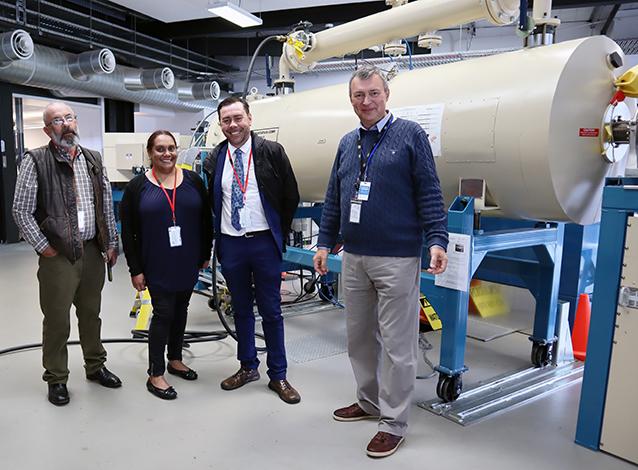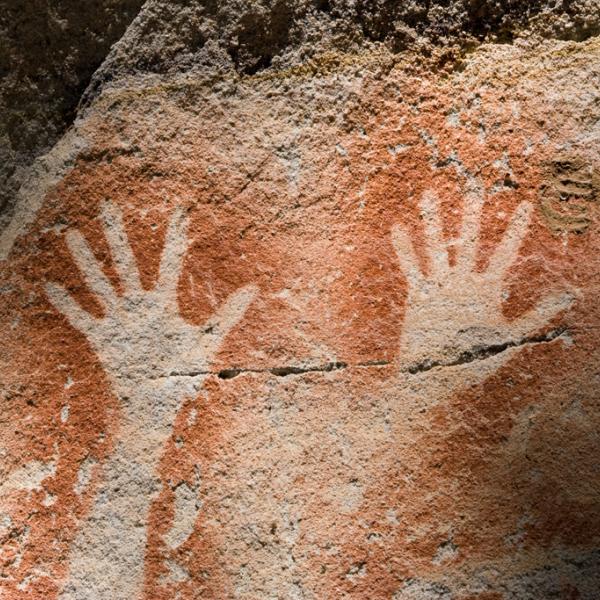

Published on the 3rd November 2021 by ANSTO Staff
A rare collection of traditional Aboriginal wooden objects in varying degrees of preservation found along a dry creek bed in South Australia have been dated to a period spanning 1650 to 1830 at the Centre for Accelerator Science at ANSTO.

Small samples of the throwing objects were sent to ANSTO and the originals were brought to Lucas Heights last year by representatives of the Yandruwandha Yawarrawarrka community as reported on this website.
Four mostly complete, non-returning boomerangs and one fragment found on Yandruwandha Yawarrawarrka country by traditional owners and national park staff would have been used in an era from 200 years before European invasion up to the time of Burke and Wills.
The implements, made by scraping with a stone tool without decoration, provide valuable insights into the tool-making ability of Aboriginal people and their diverse cultural activities and daily lives.
“For Yandruwandha and Yawarrawarrka people, the finds provide another example of how their Country continues to tell the stories of their ancestors, as well as affording a tangible connection to the knowledge passed down from their families,” said Joshua Haynes, a Yandruwandha Yawarrawarrka traditional owner and co-author of this article who travelled to ANSTO last year.
It is believed that the objects were preserved because they were submerged in the watery environment of Kinipapa (Cooper Creek) in conditions that reduced deterioration.
An archaeological team from Flinders University, Australian Heritage Services who were working with the Yandruwandha Yawarrawarrka traditional owners and ANSTO, have published the results of their study of the objects in Australian Archaeology.
Traditional owners Katheryn Litherland and Jason Litherland of the South Australian National Parks and Wildlife Service found the objects in December 2017 and January 2018 along a stretch of the then dry sections of the main channel of the Kinipapa bed when they were removing rubbish left by visitors.

(left to right) Archaeological consultant Sean Freeman, Yandruwandha Yawarrawarrka Traditional land Owners Corporation current Board member Cindy Shaefer, Joshua Haynes, former Chair of the Yandruwandha Yawarrawarrka Traditional land Owners Corporation with Dr Vladimir Levchenko in front of the VEGA accelerator where the objects were dated
The main channel of Kinipapa is generally characterised by large and deep waterholes that were important for the survival and rich cultural lives of Aboriginal people.
Because the boomerangs were found close to the surface of the creek bed, only the direct method of radiocarbon measurements could provide an age when the objects were produced.
Dr Vladimir Levchenko used accelerator mass spectrometry to obtain radiocarbon measurements, which were converted into dates using the radiocarbon calibration curve, a tool that enables scientists to convert radiocarbon years to calendar ages.
During lockdown, he provided directions virtually to community members on where and how to extract the samples for dating.
“Although there is some uncertainty with respect to absolute dating of the last 350 years, because of variations in the levels of radiocarbon in the environment, they do provide an age estimate of when the objects were made, used, or discarded,” explained Levchenko.
Because the objects were not fully buried, it was not possible to link them to stratifications in soil and rock, a method commonly used by archaeologists to verify dates.
“ANSTO proudly supports verifying the antiquity and cultural heritage of Aboriginal Australia, whether it was up to 50,000 years ago, when you get more definitive dates or in the relatively modern period, which is more challenging,” said Levchenko, who was involved in the dating of the oldest known evidence of Australian Aboriginal settlement in South Australia among other projects.
The archaeological team, led by Professor Amy Roberts at Flinders University, reported that the oldest boomerang, TSO3, (circa 1656) was comparatively well-preserved. It is a heavy boomerang with minimal curvature, an elliptic aerofoil section and a large wingspan, that could only have been used for throwing over very short distances.
They suggested that the wooden artefact was therefore much more multi-purpose and could have been used as a digging stick, infighting and hunting game.
| Artefact ID | Median Calibrated Age |
|---|---|
| TS01/1 | 1756 AD |
| TS02 | 1828 AD |
| TS03 | 1656 AD |
| TS04 | 1751 AD |
| TS05/1 | 1756 AD |
The three other projectiles and the fragment ranged in age from 1751 to 1828.
The shape of TSO1 (circa 1756) suggested it was thrown but marks created by use indicated it could have been used as a close fighting weapon or as a club to kill game.
The investigation revealed that both TSO2 (circa 1828) and TSO4 (circa 1751) were likely to have been used in fighting or in ceremonies.
Nothing could be discerned with any certainty about the use of the relatively small fragment TSO5 (circa 1756).
The archaeological team confirmed that the boomerangs were made of a type of acacia, which is known as a good hardwood and still used today, according to traditional owner Aaron Paterson, a co-author on the paper.
He suggested that the boomerangs may have been used to hunt waterfowl.
To the archaeologists, age estimates from this period of time can contribute to understanding the production of rock art and the occupation of sites.
The Yandruwandha and Yawarrawarrka Traditional Owners stressed that they are keenly aware of the potential effects of climate change in their region and seek to understand its effects in order to protect their heritage and country in a way that enables the flora and fauna to flourish.
DOI: https://www.tandfonline.com/doi/full/10.1080/03122417.2021.1994685




